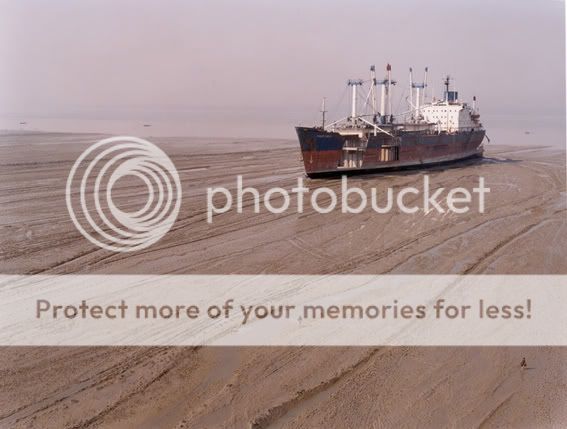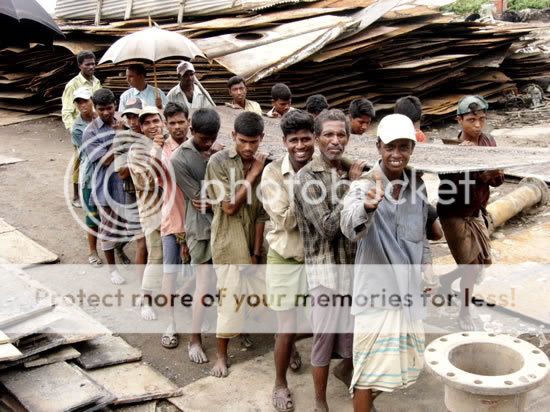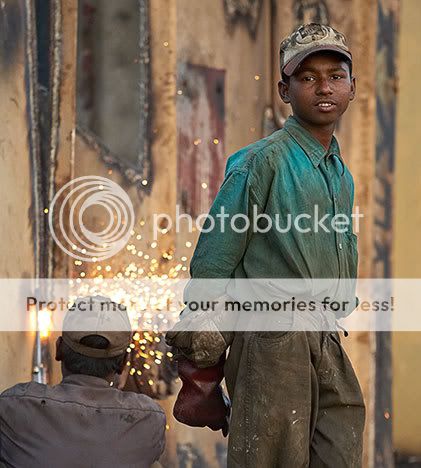It looks like you're using an Ad Blocker.
Please white-list or disable AboveTopSecret.com in your ad-blocking tool.
Thank you.
Some features of ATS will be disabled while you continue to use an ad-blocker.
0
share:
Ship breaking has gone from being a major source of employment and re-useable materials to just
another commodity that can be outsourced to developing countries at a staggering environmental and
personal health risk.
Yet major shipping companies have come to realize that the cost of breaking a ship up is more expensive than all the materials gained from it.
In countries like the UK and the USA, there are some substances on board these ships that are either banned or extremely costly and dangerous to dispose of. Asbestos is one such substance. This material has been one of the major causes of the outsourcing of retired ships to developing countries due, mostly, to the cost of its removal.
Even the removal of the metal is more expensive than the scrap value, which to me, seems ridiculous in its self if you look at the cost of razor blades these days….
One of the worlds major ship breaking ‘yards’ is now the coast line of Chittagong, Bangladesh. Ships are sailed on high tide until they run-a-ground.
googlesightseeing.com...,72.180412&z=16
Once the tide turns, then the workers come to start taking the ships apart.

www.cowlesgallery.com...
Almost every worker has no protective clothing, some even work bare footed. Yet here in the west, you can’t even enter a construction area without basic protection, steel toe boots, a hard hat and reflective vest.

www.globalgayz.com...
The chemicals and other toxic substances these ships carried will still be sloshing about inside of these great hulks somewhere, yet with amazing skill these workers, who barely manage to earn one dollar a day, break down these ships that eventually help provide the world with new cutlery and razor blades. . The ships are torn apart by hand, the most advanced tool kit is a blow torch.
Yes, these workers are paid $1 a day, yet the people who buy the ships to be broken from the owners get $35,000 for a ‘small’ propeller. The ships are bought by tonnage and cost upwards of $10 million each, so this gives you an idea of the profit that can be made from the scrap value to the people who buy the ships and pay the workers.
Between 1996 to 1998 there were 551 minor accidents, 42 major and 7 deaths.
www.ilo.org...
It’s not over once a ship has been broken down, there will be thousands of bits of scrap pieces scattered all around and the women and children come down to the shores and scour the site for every nut, bolt and rivet.
This has been going on for 35 years and not just in Bangladesh, but also in Gaddani, Pakistan.
There is hope though as the Greenpeace and the European NGO Platform on shipbreaking recently won a nice little victory over the French ship Clemenceau
www.greenpeaceweb.org...
So, the future is looking slightly better for the workers and the environment and only more and constant pressure applied to the big ship industries will combat the use of slave labour and damage to our planet caused by their cost cutting worries.

Sources and other links;
www.luminous-landscape.com...
www.greenpeaceweb.org...
www.ilo.org...
www.cbsnews.com...
www.cowlesgallery.com...
Yet major shipping companies have come to realize that the cost of breaking a ship up is more expensive than all the materials gained from it.
In countries like the UK and the USA, there are some substances on board these ships that are either banned or extremely costly and dangerous to dispose of. Asbestos is one such substance. This material has been one of the major causes of the outsourcing of retired ships to developing countries due, mostly, to the cost of its removal.
Even the removal of the metal is more expensive than the scrap value, which to me, seems ridiculous in its self if you look at the cost of razor blades these days….
One of the worlds major ship breaking ‘yards’ is now the coast line of Chittagong, Bangladesh. Ships are sailed on high tide until they run-a-ground.
googlesightseeing.com...,72.180412&z=16
Once the tide turns, then the workers come to start taking the ships apart.

www.cowlesgallery.com...
Almost every worker has no protective clothing, some even work bare footed. Yet here in the west, you can’t even enter a construction area without basic protection, steel toe boots, a hard hat and reflective vest.

www.globalgayz.com...
The chemicals and other toxic substances these ships carried will still be sloshing about inside of these great hulks somewhere, yet with amazing skill these workers, who barely manage to earn one dollar a day, break down these ships that eventually help provide the world with new cutlery and razor blades. . The ships are torn apart by hand, the most advanced tool kit is a blow torch.
Yes, these workers are paid $1 a day, yet the people who buy the ships to be broken from the owners get $35,000 for a ‘small’ propeller. The ships are bought by tonnage and cost upwards of $10 million each, so this gives you an idea of the profit that can be made from the scrap value to the people who buy the ships and pay the workers.
Between 1996 to 1998 there were 551 minor accidents, 42 major and 7 deaths.
www.ilo.org...
It’s not over once a ship has been broken down, there will be thousands of bits of scrap pieces scattered all around and the women and children come down to the shores and scour the site for every nut, bolt and rivet.
This has been going on for 35 years and not just in Bangladesh, but also in Gaddani, Pakistan.
There is hope though as the Greenpeace and the European NGO Platform on shipbreaking recently won a nice little victory over the French ship Clemenceau
Justice for the environment as French Government takes back the Clemenceau
Paris, 15 February, 2006 -- Greenpeace today celebrated President Jacques Chirac's decision to call back the decommissioned toxic aircraft carrier, the Clemenceau, to France from its journey to the ship-breaking yards in Alang, India.
www.greenpeaceweb.org...
So, the future is looking slightly better for the workers and the environment and only more and constant pressure applied to the big ship industries will combat the use of slave labour and damage to our planet caused by their cost cutting worries.

Sources and other links;
www.luminous-landscape.com...
www.greenpeaceweb.org...
www.ilo.org...
www.cbsnews.com...
www.cowlesgallery.com...
new topics
-
Comparing the theology of Paul and Hebrews
Religion, Faith, And Theology: 1 minutes ago -
Pentagon acknowledges secret UFO project, the Kona Blue program | Vargas Reports
Aliens and UFOs: 1 hours ago -
Boston Dynamics say Farewell to Atlas
Science & Technology: 1 hours ago -
I hate dreaming
Rant: 1 hours ago -
Is the origin for the Eye of Horus the pineal gland?
Philosophy and Metaphysics: 3 hours ago -
Man sets himself on fire outside Donald Trump trial
Mainstream News: 3 hours ago -
Biden says little kids flip him the bird all the time.
2024 Elections: 3 hours ago -
The Democrats Take Control the House - Look what happened while you were sleeping
US Political Madness: 4 hours ago -
Sheetz facing racial discrimination lawsuit for considering criminal history in hiring
Social Issues and Civil Unrest: 4 hours ago -
In an Historic First, In N Out Burger Permanently Closes a Location
Mainstream News: 6 hours ago
0
